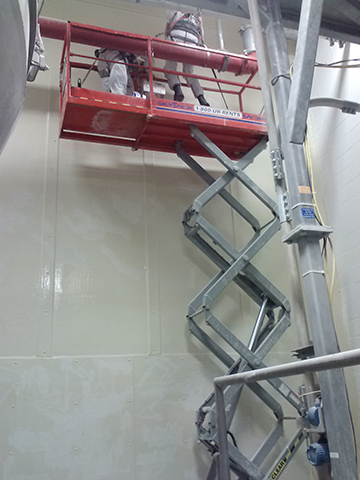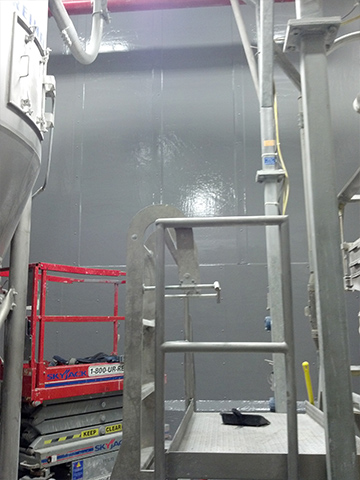When one of the world’s largest producers of baked goods had two problems on their hands — a corroding ice machine and beetles entering their flour room — their solution was Ecodur 201. The producer, which wishes to remain unnamed, called Aquablocx, a Tennessee-based company that specializes in repairing storage tanks (e.g., water, grain, chemical, oil, fuel, and wastewater) of all shapes and sizes using a plant-based coating material.
Aquablocx sent manager, Ed Harnage, and
three other crew members to the site to complete the projects. Both jobs, which
were completed over two solid weekends in May 2014, were slightly challenging,
given all of the safety regulations that come with working in a food plant.
According to Harnage, “Anytime you are
working with a food manufacturer, it brings added challenges. There are a lot
of people watching and overseeing to make sure all safety and FDA [Food and
Drug Administration] requirements are met. These days, with the threat of
poison, Homeland Security is even involved.” Despite the added hoops, the team emerged
successful.
A Chilly Situation
Harnage
often uses a four-person crew because it is effective and efficient, and he did
the same on this project. Each member has an important role to play: One team
member does the prep work and masking, one works outside in a trailer
overseeing the pumps and machines, one member handles up to 200 feet (61.0 m)
of hose, and one applies the coating.
 The crew got to work on the 10-foot-long (3.0
m), 6-foot-tall (1.8 m), 6-foot-wide (1.8 m) ice machine first. The machine was
aluminum and had no previous coating. The space was room temperature, but the
equipment was cold, causing condensation and corrosion.
The crew got to work on the 10-foot-long (3.0
m), 6-foot-tall (1.8 m), 6-foot-wide (1.8 m) ice machine first. The machine was
aluminum and had no previous coating. The space was room temperature, but the
equipment was cold, causing condensation and corrosion.
“The outside of the machine was quite
corroded because of too much moisture,” said Harnage. “We initially cleaned the
inside of the ice machine to see if that was the answer, but there was still
condensation forming on the outside and leaking onto the floor.”
The machine was shut down for a day to get
a better understanding of the problem and ultimately to fix it. Fitted with sheet
metal on the outer surface, it had a thick layer of insulation between the exterior
and frozen inside. Luckily, nothing was rusting through to the inside. With a
plan set, they were ready to get to work the next day, which was dedicated to
surface prep and coating.
The crew cleaned the outside of the
machine, finding all of the areas where the sheet metal was rusted, and
replaced those spots. Next, they maneuvered around many electric and water
connections — disconnecting them when possible and masking others so that they remained
free from overspray. They used a grinder wheel to do the surface prep. Once all
of the surfaces were inspected and determined to be clean, dry, and tight, they
sprayed Ecodur 201, which was applied at approximately 40 mils (1,016.0 microns),
using a 3,500 psi (24.1 MPa) dual-component pump manufactured by Graco.
The
coating, which is manufactured by Castagra Products Inc., has fast application
and fast curing rates, making it a favorite in the industry for tank coating. It
does not need a primer and is a single application process. Once the coating job
was inspected, the machine was put back into service.
The White Stuff
As
one might guess, raw flour is shipped to the baked goods plant in trucks. But the
trucks also brought some unwanted visitors: beetles. The bugs were coming
through the concrete block between the mechanical room and the flour room. The general
manager of the plant tried to fix the problem himself, installing fiber-reinforced
plastic (FRP) wall boards. Unfortunately, the boards were no match for the
bugs.
Enter Harnage and his crew. Instead of
working inside the flour room, they worked in the adjoining mechanical room,
because the flour room was, well, full of flour. “The way Ecodur 201 adheres,
you can apply it from either the positive or negative side,” explained Harnage.
“It is unlike other products where you must use the positive side.”
With 22-foot-tall (6.7 m) walls, the team
used a motorized scaffold lift to get the job done. “Safety is a top priority
for us,” said Harnage. “We have weekly safety meetings and have been certified
in CPR [cardiopulmonary resuscitation] and confined spaces, as well as climbing
and fall protection, which came in handy for this project.”
 The team members, who wore safety
harnesses with shock-absorbing lanyards, were hooked to overhead beams. They
also wore gloves, hardhats, safety glasses, steel-toed shoes, spray suits, and
respirators.
The team members, who wore safety
harnesses with shock-absorbing lanyards, were hooked to overhead beams. They
also wore gloves, hardhats, safety glasses, steel-toed shoes, spray suits, and
respirators.
To begin, they used a wire brush to abrade
the surface, and then they spray-applied the walls with an average thickness of
40 mils (1,016.0 microns) of Ecodur 201.
“This
was our first time doing FRP board,” said Harnage. “But I had no question it
would work. [Ecodur 201] is about the stickiest stuff I’ve ever seen. It’s like
coating with Elmer’s glue!”
Harnage’s presumption was correct: The
flour room’s puzzle was solved, and the coating sealed the room tight.
The Castor Coating
“Because
Ecodur is NSF-61 compliant, we often use it for work in the food industry,” said
Harnage of the National Science Foundation (NSF)/American National Standards
Institute (ANSI) Standard for Drinking Water System Components. “With this
material, we don’t have to shut down the plant. Everything is pretty much
business as usual, which makes it much easier for the company.”
Had the Aquablocx team used an epoxy or
another solvent-borne chemical, the food plant would have had to contain the
area and move employees. Ecodur 201, on the other hand, is plant-based, which
means it has no volatile vapors. It uses castor bean oil instead of petroleum
oil, making it natural and odorless.
“At
one point, castor beans were illegal to grow in the United States because castor
seeds produce ricin, which is highly toxic and used to make Anthrax,” Harnage said.
“Our CEO worked with Texas A&M to develop a low-ricin castor bean that they
have been able to grow in Texas.”
According to Castagra’s website, they
chose to work with castor oil because of its complexity, which aids the
creation of a robust, stable plastic. In internal applications, and under
normal atmospheric conditions in commercial buildings and schools, it should likely
last well in excess of a century, making it an excellent candidate for asbestos
encapsulation.
Harnage recounted an interesting experience
during the project: “At one point, the plant manager came in and told us to let
him know when we were going to start spraying because he wanted to watch. When we told him we were already halfway
done, he was astounded. ‘No way!’ he said. He’d been walking up and down the
hallway all morning thinking for sure he’d smell it when we began.”
Done and Dusted
“A
year later, everything is perfect,” Harnage said. The beetles are gone and so is the
corrosion on the ice machine. The food plant was so pleased with Harnage and
the rest of his Aquablocx crew that they hired them for four more projects.
“When you have a great crew like I do, you
figure out what needs to be done, get out, and execute,” affirmed Harnage.